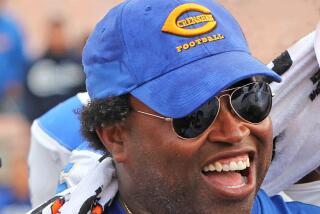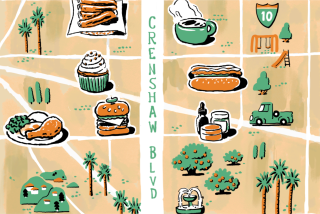ROLE MODEL
- Share via
Its number is 8802.
Its weight is 19 ounces.
It’s 34 inches long.
It’s 32 years old.
It’s been stolen twice.
It’s been returned twice.
It’s Ben Crenshaw’s Wilson putter, the one otherwise known as Little Ben and the one that has personally escorted more golf balls into more golf holes than just about any putter in the history of golf.
All you need to know how about Crenshaw’s excellence as a putter is that not once, but twice he successfully toured Augusta National and won the Masters on greens so slick and fast and treacherous that the best way to prepare for them was rolling marbles across a satellite dish.
Now, Crenshaw is an acknowledged expert on putting, and he’s quite possibly the best ever, which means advice on how to make putts is worth listening to.
Here are his words of wisdom: “Putting can be the most frustrating thing you’ve ever known.”
So there you have it, a little encouragement from the master putter. Feel better now?
At 46, with 19 tournament titles stuffed in his golf bag and two of them from the Masters, Crenshaw has long been a familiar sight holing putts. Davis Love III said the list of great putters of this generation begins with Crenshaw.
“Bumpy greens, slow greens, fast greens, wet greens, dry greens, doesn’t make any difference to him,” Love said. “He knows how to roll the ball.”
Crenshaw has been rolling the ball with his heel-shafted Wilson 8802 medium-weight putter since 1966, when he was 14. It’s not very long, not even three feet long, but Crenshaw doesn’t care because he can hang his arms comfortably without bending them.
He usually carries two more like it as backups, but neither is exactly like Little Ben, which has served him well since he was a teenager making putts.
Even then, with Harvey Penick teaching him, Crenshaw always tried to keep putting as simple as possible.
“Be yourself,” Crenshaw said. “To be a good putter, you can’t try to look like somebody else.
“Everything blends into a very, very fine touch and imagination . . . the ability to know how hard to hit the ball and how the greens are going to react. Not everybody can put the ball in the proper place, but the very fine putters always seem to have the ball around the cup at a certain speed.
“Gosh, people like Bobby Locke and Jerry Barber and Billy Casper, and Jack Nicklaus--I don’t think enough has been said about his putting. . . . He just never looked like he was going to three-putt--they always were around the hole.”
Crenshaw said he always has felt comfortable over the ball. From there, he lets his anticipation take over.
“I think you have to have an ability to know what the ball’s going to do,” he said. “I think all good putters have that.”
Penick taught Crenshaw “to give luck a chance,” which brought to Crenshaw’s mind something Bobby Jones once said.
“There are four entrances to the hole: the front, back and the two entrances on the side. The ball can fall in on any side, can’t it?”
It can if you can putt like Crenshaw.
More to Read
Go beyond the scoreboard
Get the latest on L.A.'s teams in the daily Sports Report newsletter.
You may occasionally receive promotional content from the Los Angeles Times.










